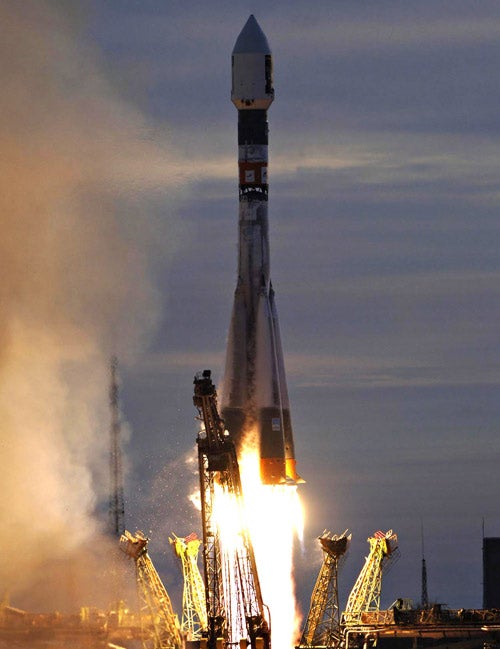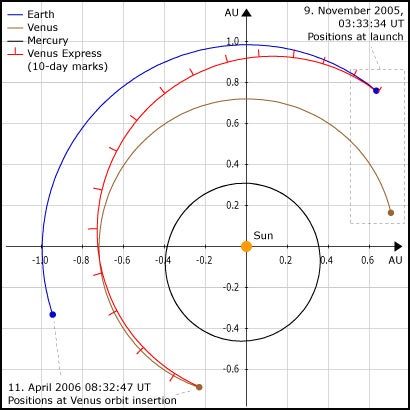A 12-year hiatus in Venus exploration ended Tuesday night with the European Space Agency’s (ESA) launch of Venus Express. At 10:33 p.m. EST, the Soyuz-Fregat rocket carrying the spacecraft lifted off from Kazakhstan’s Baikonur Cosmodrome. Eighty-two minutes later, the Fregat upper stage burned a second time and sent Venus Express into an escape trajectory that will deliver it to Venus in April 2006.
Venus outshines everything in the sky except the Sun and Moon. It’s Earth’s closest planetary neighbor and orbits the Sun about 30-percent closer. When Venus passes between Earth and the Sun, the planet lies about 26 million miles (42 million kilometers) away — roughly 100 times farther than our own Moon.
Venus Express is the first probe dedicated to studying our neighbor planet since NASA’s radar-mapping Magellan mission launched in 1989. Magellan peered through Venus’ clouds, using radio waves to map 98 percent of the planet at high resolution, revealing impact craters, rift valleys, and volcanoes. It burned up in the planet’s atmosphere in late 1994. Venus Express, ESA’s first Venus mission, instead will focus on the planet’s peculiar atmosphere.
A thick mantle of clouds shrouds Venus and hid its true character until the 1950s. Until then, astronomers thought of Venus as Earth’s twin based on similarities like size, mass, and distance from the Sun.
Venus has no oceans, lakes, rivers, or rainfall. The planet’s high surface temperature — a constant 870° Fahrenheit (465° Celsius), or nearly twice the temperature of an oven’s broiler — prevents any liquid water. In fact, Venus is 100,000 times drier than the driest place on Earth. Call it global warming gone wild. The thick carbon-dioxide atmosphere lowers the planet’s ability to radiate heat into space, so the temperature rises.
Yet scientists think Venus may once have held oceans, just like Earth, and they’d like to understand why the two worlds are so dissimilar now.
Existing meteorological models fail to reproduce the venusian atmosphere’s behavior. For example, clouds at the equator circle the planet in just 4 days. Several spacecraft have seen hints of lightning in the atmosphere, but definitive evidence has yet to be found.
Although scientists have identified sulfuric acid droplets in the upper cloud deck, spacecraft passing through lower clouds suggest the presence of crystalline particles, not droplets. If so, their chemical makeup must be more exotic than sulfuric acid.
Venus Express will cruise through space for 153 days. When captured by Venus’ gravity, the spacecraft will adjust its orbit over a period of 5 days, eventually looping around the planet’s poles. At its closest, it will reach an altitude of 155 miles (250 km) above the planet’s high northern latitudes. At its farthest, it will be 41,000 miles (66,000 km) above the planet’s southern hemisphere.
Mission planners expect the mapping mission to last 500 Earth days, but Venus Express carries enough fuel to maintain its polar orbit twice this long.
ESA postponed the launch, originally scheduled for October 26, when pieces of insulating material from the launcher’s Fregat upper stage were found to have contaminated the spacecraft. Fortunately, the pieces were easy to identify by eye or with the help of ultraviolet lamps. Technicians carefully removed the particles using tweezers, vacuum cleaners, or nitrogen-gas airbrushes.












